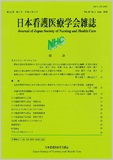Japanese
English
- 有料閲覧
- Abstract 文献概要
- 参考文献 Reference
目的: 自分を教材にして血糖自己測定を学ぶ学生の経験内容を明らかにする。
方法: 血糖自己測定演習に参加した26名の演習レポートを、テーマティック・アナリシス法で分析した。
結果: 学生の経験内容は、【穿刺と直面したことでの気づき】【SMBG 実施を想定した思い】【自分で決断したという思い】【穿刺までに自覚した気持ち】【SMBGの準 備を通した気づき】【穿刺の体験からの気づき】【SMBG 実施からの学び】【恐怖心と緊張を伴う実施での気づき】【SMBG に対する改められた認識】【体験を学びとして意味づける】のテーマに分類された。
結論: 自分を教材に血糖自己測定を学ぶ学生の経験は、ストレスコーピング過程と類似することが明らかになった。学生の関心の高い課題と意思決定を組み合わせた授業設計は、学びを能動的で効果的する可能性が考えられた。
Purpose: To clarify the contents of students’ experiences in learning SMBG by practicing on themselves.
Methodology: Exercise reports from 26 students who participated in a SMBG exercise were analyzedusing the thematic analysis method.
Results: The students’ experiences were categorized into the following themes: “Realizations whenfacing a puncture,” “Anticipation of implementation,”“The feeling of having made the decision on one’sown,” “Feelings the student was aware of leading up to the puncture,” “Realizations through the processof preparing for SMBG,” “Realizations through experiencing a puncture,” “Lessons learned from implementationof SMBG,” “Realizations from implementation accompanied by fear and nervousness,”“Revised perceptions of SMBG,” and “Making sense of it as a learning experience.”
Conclusion: The experiences of students learning how to self-monitor blood glucose by practicingon themselves were found to be similar to the process of coping with stress. Lesson plans that combine decision-making with tasks that are of high interest to the students are thought to have the potential to make learning more active and effective.
Copyright © 2024, Japan Society of Nursing and Health Care All rights reserved.


